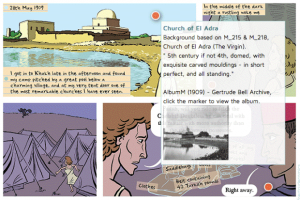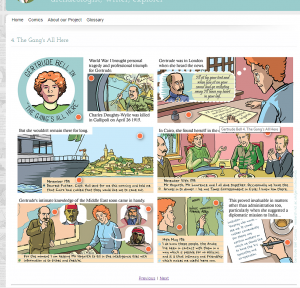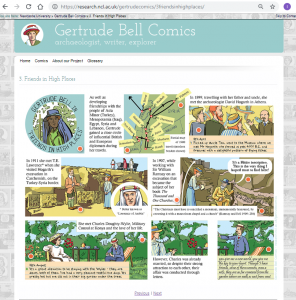How do you translate images and stories to open them up to new audiences without losing their meaning? Early Career Researchers Lydia Wysocki and Sana Al-Naimi talk with Dr Eve Forrest about their recent work on an ESRC IAA project translating the archive-based comics ‘Gertrude Bell: Archaeologist, Writer, Explorer’
EF: Can you tell me a bit more about the original research project?
LW: The research began as an educational project aimed to support younger historians access the digitised Gertrude Bell archive (recognised by UNESCO as of global significance, and with a strong contemporary resonance). This new approach to archives, education and webcomics was achieved by our interdisciplinary team including cartoonist John Miers, Senior Lecturer in Archaeology Mark Jackson, and web designer Brittany Coxon, who worked with us and the Young Archaeologists’ Club (YAC) to develop a series of seven online comics that tell episodes in the life of Gertrude Bell. The images and words in the comics were developed from primary source material in Special Collections.
EF: How did the impact project begin?
LW: After we had done the first part of the research project and published the comics online, we saw that YAC members found the website intuitive to use and clicked through to digitised archive photographs, but tended not to click on links to transcribed text. When the archive was digitised 20 years ago it was aimed at academic researchers, so it’s not surprising that it’s less appealing to general interest readers. Looking at web analytics we also saw that quite a bit of web traffic to the site was coming from Turkey and from Arabic speaking countries. We realised that we had a great base with the comics but could do more to enable more young people in the UK and internationally to become interested in history and primary archival material through the comics, particularly given the complex issues that these comics begin to address.
SA-N: I joined the project at this stage of translating from English to Arabic, working with Saziye Tasdemir who was translating from English to Turkish. It was great to read the comics as accessible snapshots of complex material that I was already familiar with from working with the Bell archive for my PhD thesis about Gertrude Bell’s influence on architecture and urbanism in twentieth century Iraq. I knew it was a rich source of visual and verbal primary sources with potential to be more widely used, but also knew that there would be particular cultural sensitivities to address as part of this translation process. As an archaeologist and academic lead for the Bell archive Mark had already highlighted sources that are real treasures of the archive, and I was able to add to this with a focus on the architecture and culture of Iraq.
EF: Certain things can often be ‘lost in translation’ did you find the same thing with the comics?
SA-N: Translating will always be a challenge, particularly around areas of cultural sensitivity. Gertrude Bell was an extraordinary but also contentious figure. She was unusual as a woman of power in the Middle East, she was fluent in Arabic and worked for the preservation of antiquities, however this was still within the framework of colonialism and the British Empire. When we were translating the comics for this new audience we had to keep that in mind. There was also more practical changes to make. For example each comic had to be flipped to read right to left in Arabic rather than left to right in English: but as an architect, I knew it was essential that iconic buildings were still drawn accurately not as mirror images.
LW: Working with the original cartoonist John Miers and with Sara Qaed as the Arabic-speaking cartoonist relettering the comics has been a positive process. These comics are complex texts in their own right with speech bubbles, thought bubbles, diary extracts, letters, and narrative voiceovers – so working with John and Sara as experienced comics creators to ensure that the reading order within the comics still makes sense is just as important as the innovation of using hyperlinks to show the original archive content in context.

Excerpts from the Gertrude Bell comics with the popup/hyperlinked archive content (all © John Miers and the Gertrude Bell comics project)
EF: The project was only for a year, what are the other areas you would like to develop in the future?
SA-N: There are more stories to tell, particularly around Bell’s role in the founding of Iraq as a country and her influential 1920 White Paper ‘Review of the Civil Administration of Mesopotamia’. There’s potential to make this visually really interesting, which is great for our interdisciplinary team. Mark Jackson and I were discussing links between the Lowthian Bell family’s patronage of Arts and Crafts artists in the UK, and Bell’s interest in the the geometric and symbolic styles of art and architecture in the Middle East at that time. It’s great to work with John as an artist who picks up on these visual references, and we’re all excited to see how this imagery comes through in the new comics we’re working on.
LW: This project is still ongoing really and is complex in terms of time and resources, as well as the translation in itself. There were a number of useful things we learned in the process that we could map to other archives, particularly when thinking of new users accessing archives as well as the translation of resources too. For example there is huge potential in this work being developed as part of the curriculum and into richer educational resources, and we’re working with student intern Brad Lloyd to develop resources for A-level students undertaking independent study so there is a great potential new audience there. Brad joined the project as an A level student applying to study Archaeology here at Newcastle University: he is now starting his Archaeology degree here, so it’s a benefit to our project to work with someone at that transition stage, and hopefully a benefit to Brad too in building his CV. Comics are also a unique and innovative way to explore archives and artefacts, particularly here in using web comics with hyperlinked online archives. Overall we’ve had encouraging feedback from readers so far and want to continue making resources that help a range of readers around the world access the Bell archive and explore the significance of this history.
All the Gertrude Bell comics can be found here


